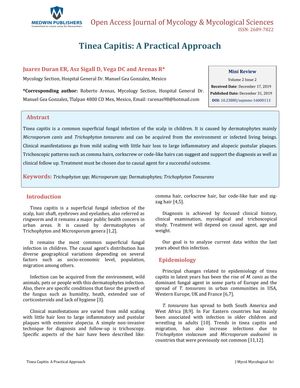Tinea Capitis: A Practical Approach
January 2019
in “
Open access journal of mycology & mycological sciences
”

TLDR The article concludes that proper antifungal treatment is essential for treating scalp fungal infections in children, and trichoscopy is useful for diagnosis and monitoring.
The 2019 article provided an overview of tinea capitis, a scalp fungal infection primarily affecting children, and discussed its diagnosis, epidemiology, and treatment. It noted the rise of Trichophyton tonsurans as a common cause and the utility of trichoscopy for diagnosis and treatment monitoring, revealing specific hair patterns like comma and corkscrew hairs. The paper emphasized the importance of choosing the right antifungal treatment—terbinafine for Trichophyton spp. and griseofulvin or itraconazole for Microsporum spp.—and indicated that topical therapy alone is not effective. It also mentioned the emergence of Trichophyton violaceum in Milan's pediatric population and the use of corticosteroids for kerion caused by Microsporum canis. The document highlighted that trichoscopy could predict clinical cure and stressed the necessity of systematic antifungal therapy for affected children. Specific study sizes were not mentioned in the summary provided.


